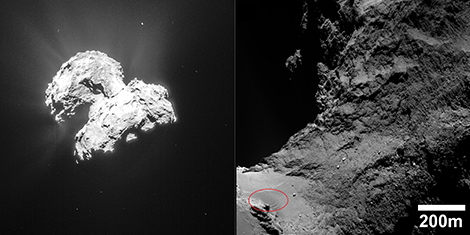Séminaire de Mécanique d'Orsay
Le Jeudi 21 juin 2018 à 14h00 - Nouveau bâtiment FAST
Giant ripples on comet 67P/Churyumov-Gerasimenko sculpted by sunset thermal wind
Philippe Claudin
PMMH ESPCI, Paris
The recent approach of comet 67P/Churyumov-Gerasimenko by the spacecraft Rosetta has revealed the presence of astonishing dune-like patterns. How can the radial outgassing, caused by heating when passing close to the sun, produce a vapor flow along the surface of the comet dense enough to transport grains? We show that the vapor flow emitted by the comet around its perihelion spreads laterally in thermal winds, due to the strong pressure difference between zones illuminated by sunlight and those in shadow. Drawing on the physical mechanisms at work for the formation of dunes on Earth and planetary bodies, we can explain the emergence of these bedforms in such extreme cometary conditions at the observed crest-to-crest size, about 10 m. Although generated by a rarefied atmosphere, they are in fact analogous to ripples emerging on granular beds submitted to viscous shear flows. Ref: P. Jia, B. Andreotti and P. Claudin, Proc. Natl. Acad. Sci. USA 114, pp 2509-2514 (2017).

À gauche, une photo de la comète Tchouri où l'on distingue le dégazage de vapeur d'eau qui entraîne des poussières (copyright ESA/Rosetta/NAVCAM). À droite, la région du cou entre les deux lobes de la comète. On y observe différents types de relief, dont ces dunes au bas à gauche (cercle rouge), dans la zone sableuse.
